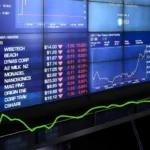Key Points
- Jefferies rates Instacart as “Hold” with a $45 price target, citing concerns over market share and advertising growth.
- Instacart operates in the $1.3 trillion U.S. grocery market, but only 14% of grocery sales occur online, showing growth potential.
- Due to stiff competition, Jefferies projects Instacart’s GTV to grow at 6.5% annually, slower than the broader online grocery market.
- Instacart’s market share declined from 24% in 2021 to 19%, and further losses are expected due to competition from Amazon and Walmart.
Jefferies analysts have initiated coverage of Instacart (NASDAQ: CART) with a “Hold” rating and a price target of $45, highlighting two key concerns: the company’s declining market share and uncertainty around advertising growth. Despite Instacart’s position in the rapidly growing online grocery delivery space, Jefferies believes these risks could limit the company’s upside potential in the coming years.
Instacart operates in the vast $1.3 trillion U.S. grocery market, which is still in the early stages of transitioning to online platforms. Currently, only 14% of grocery sales occur online, significantly lower than the 27% online penetration in other retail sectors. This gap suggests significant potential for growth as more grocery shopping moves online. However, Jefferies projects that Instacart’s gross transaction value (GTV) will grow at an annual rate of just 6.5% from 2024 to 2027, a pace that is roughly half the rate of the broader online grocery market.
The analysts attribute this slower growth to the intense competition Instacart faces from larger rivals like Amazon (NASDAQ: AMZN) and Walmart (NYSE: WMT), which hold dominant positions in the market with 24% and 34% shares, respectively.
Instacart’s market share has already fallen from 24% in 2021 to 19% today, and Jefferies expects this decline to continue. The firm explains that Amazon and Walmart have more diversified product offerings and more efficient customer acquisition strategies, making it difficult for Instacart to compete.
Another critical concern is Instacart’s heavy reliance on its advertising business to drive profitability. Instacart has built a substantial $1 billion advertising segment, which plays a major role in its overall financial performance. Advertising accounts for about 75% of Instacart’s margin expansion and half of its EBITDA growth. However, Jefferies notes that Instacart’s ad penetration has stagnated since the fourth quarter of 2023, raising concerns about future earnings. A slowdown in advertising growth could significantly impact the company’s overall financial outlook.
Given these challenges, Jefferies believes Instacart’s discounted valuation is justified. The firm’s $45 price target is based on a discounted cash flow (DCF) analysis, which implies an 11x 2026 EV/EBITDA multiple, representing a 15% discount compared to its peers. This is mainly due to Instacart’s history of market share losses and the uncertainty surrounding its advertising growth.











